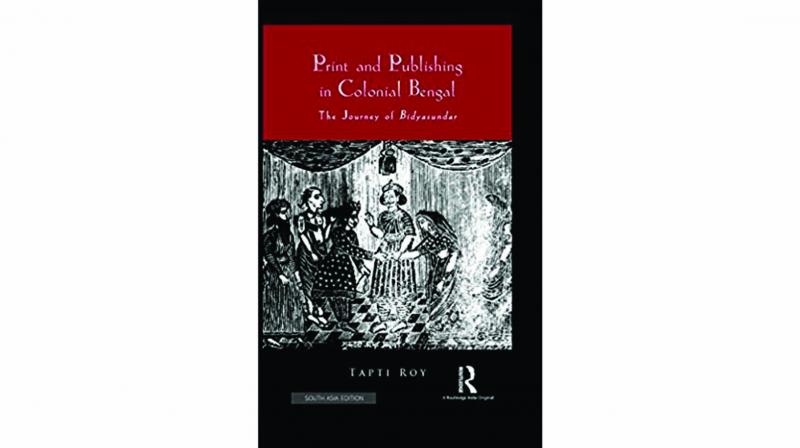Annadamangal and Bengal's tryst with the printed word
The book narrativises an evidenced historical journey without losing sight of the topicality and contemporaneity of its theme.

Bidyasundar, the story of Bidya, a princess from the royal city of Bardhaman in Bengal, and her love affair with Sundar, a southern prince from Kanchi, can be traced at least as far back as medieval Bengali poetry. It was, however, through the work of Bharatchandra, 18th century Bengal’s most illustrious poet, that it finally found a wider audience. Printed copies published from the early years of the 19th century rapidly resulted in its dissemination as the foremost example of popular Bengali literature at the time. Bharatchandra’s poem appropriated the legend into the folds of his Annadamangal kavya and set it to verse that was at once ornamental, lyrical, sensuous, and witty, framing a narrative that navigated deftly through myth, legend, history, fact, fiction and fantasy. It formed a model for future poets, a site for debate on matters of literary and popular taste, and a narrative that was adapted for prose, performance and in the 20th century, for film.
Tapti Roy’s book chronicles the journey of the Bidyasundar story, moving effortlessly across cultures of writing, print and performance, and in the process, chronicling a century of evolution and achievement in 19th century Bengal. Rather like “stitching a quilt of dissimilar and variegated threads, materials, sizes and stitches”, the book weaves a rich tapestry which combines the diverse journeys of writing, printing, publishing, missionary activity, theatre, an array of movements in religious and philosophical discourse, and advances in scientific innovation and technology. It distils the fruits of diverse bodies of research into a single narrative that is at once enduringly complex and disarmingly lucid. Roy’s book builds on the earlier work of generations of historians, but emerges as a tour de force in its own right, and is a rivetting read.
Little nuggets of lively detail are sprinkled across the text (for example “rural scribes were notorious for making mistakes in making copies”), which sparkle with the measured use of obiter dicta. The complexity and density of the project is easy to miss, because of Roy’s syncretic narrative style and assured handling of a rich body of material, uninhibited by easy recourse to academic jargon. What emerges is a vivid account of a society undergoing rapid transformation, its identity and world views consciously reconfigured by a polymath intelligentsia whose Anglophilic sensibilities were tempered by a strong sense of pride in their Bengali heritage.
In less than 50 years, Bengal worked its way through the sum total of more than 300 years of the European evolution in industrial printing, and by the beginning of the 20th century, Upendrakishore Ray was already making seminal contributions to the future of printing technology through his articles on half tone printing in Penrose’s Annual. The impact of industrial printing contributed significantly to the rapid and giant scientific and cultural strides made by a generation of pioneering thinkers, scientists, innovators, inventors and writers who between them managed to engineer a societal transformation whose eventual fallout would be the rise of a national consciousness around Bengal’s, and later India’s, political identity.
The book narrativises an evidenced historical journey without losing sight of the topicality and contemporaneity of its theme. The popularity of printed books in Bengal was based in part on their claim to be improvements as “hand copied manuscripts were seldom free from errors”, “which in a competitive field was publicised as a selling point”. The printed word’s emergence as “definitive” was built on the reader’s “trust” in the machine’s ability to exactly replicate the act of printing on each new sheet of paper, free of human error. The subtext is a timely reminder of the printed word’s reputation as a marker of “reliability”, which has suffered over the last two decades with the emergence of virtual platforms and social media as sources of “published” but unverified and often inaccurate information.
This contemporaneity extends to Roy’s reading of the moral panics associated with the wider circulation of “literature” made possible by 19th century print culture in Bengal. The suspicions arising from the reception of Bidyasundar’s popularity with female readers for its “gross and immoral tendency”, bear a striking similarity with some of the societal outrage on display when the “romantic” content of Bankimchandra’s novels captured the imagination of female readers a few decades later.
This moral judgementality is hardly a thing of the past. Well into the 21st century, literature (and other humanities) programmes in universities are repeatedly compelled to justify their “usefulness” and sometimes their very existence. The discomfort around them is caused in part by the significantly high numbers of
female students questioning conventional value systems through the study of literary works, applying such insidious tools as critical thinking which have, over centuries, repeatedly threatened hegemonic practices and social conformism.
It is these twin abilities to generate and enrich debate and to fill a much needed gap in scholarship, tracing together cultures of production, dissemination and reception of literary works in 19th century Bengal, that make Roy’s book so distinctive. It is a pity, and an irony too, that such a seminal work on the printed text is sullied by a catalogue of errors which should not have escaped the eyes of an attentive proof-reader.
The reviewer teaches film and media studies at Bath Spa University at Bath, England.
